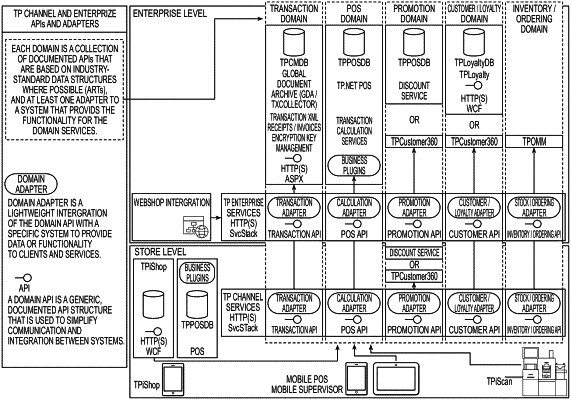| CPC G06Q 20/202 (2013.01) [G06Q 20/20 (2013.01); G07G 1/14 (2013.01); H04L 12/4633 (2013.01)] | 1 Claim |

|
1. A method for configuring a Point of Sale (“POS”) system, which uses several peripheral devices to complete a transaction, and uses a device server at which the peripheral devices are registered and logically connectable to a plurality of POS devices, comprising the steps of:
before starting a transaction on a first POS device of the plurality of POS devices, requesting at least one peripheral device of the several peripheral devices from the device server to assign the at least one peripheral device to the first POS device;
once the request is granted, starting the transaction with the first POS device and informing the device server about the start of the transaction for blocking access to the at least one peripheral device for a second POS device of the plurality of POS devices;
providing a transaction handling on the plurality of POS devices indicating that the transaction is pending and that the peripheral device used by the first POS device cannot be used by the second POS device, the transaction handling also providing this information to the device server;
when a request for the at least one peripheral device from the second POS device is received by the device server, it is checked if a transaction is pending for the at least one peripheral device and where a transaction is pending, the request is automatically declined, and if no transaction is pending the at least one peripheral device is reassigned to the second POS device;
where the at least one peripheral device is physically connected to the first POS device and where a device service is running on the device server that controls the communication to the device server and to the at least one peripheral device and supports assignment by the device server;
where the device service tunnels the communication between the device server and the at least one peripheral device, such that the first POS device does not directly communicate with the connected at least one peripheral device but with the device service and the device server;
where each of the first and second POS devices is configured to use the several peripheral devices to complete a transaction;
where the several peripheral devices are transparently presented to the first POS device and the second POS device, whereby it is not visible to the first POS device and the second POS device to which of the other of the first POS and the second POS device the several peripheral devices are connected;
refactoring a POS printer logic into a plug-in;
granting use of scales to the plurality of POS devices through a scale transaction module integrated to the device server;
where when no transaction is pending and the at least one peripheral device is assigned to the first POS device and when the second POS device is requesting the at least one peripheral device the device server sends a confirmation message to the first POS device to which the at least one peripheral device is assigned requesting a confirmation to release the at least one peripheral device, and requesting a response of a user of the first POS device;
where when no response to the confirmation message is sent from the first POS device for a predetermined time interval the at least one peripheral device is removed from the first POS device and reassigned to the second POS device;
where the at least one peripheral device is one of a POS printer, a line display, a scale, a fiscal printer, a scanner, and a cash drawer;
wherein the request is automatically granted when one of the plurality of POS devices that is currently connected and stationary does not respond in a predetermined amount of seconds;
and further comprising:
implementing business logic applied by the device service and the plurality of POS devices as plug-ins to thereby avoid implementing device integrations twice; and
routing, with the device server, a definition of an interface that the plurality of POS devices use.
|